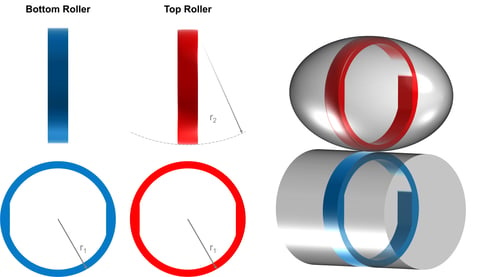
Rolling sliding contacts are integral to bearings, power transmission systems, rail-wheel interface and rolling mills are typically subjected to high contact pressures (1.5 to 4 GPa) and slip ratios (0 to 100%). The actual slip ratios depend either on the design configuration (e.g., drive and driven gear sizes) or on the traction characteristic between the surfaces (e.g., cam-follower contact, rolls in steel mills) governed by the lubricant rheology and pressure-viscosity characteristics (see Figure 1A). Higher traction increases the subsurface shear stress magnitude and moves the maxima closer to the surface leading to surface distress (see Figure 1B).
 Figure 1. Characteristic traction curve for lubricants vs % slip with dominant failure mechanisms (A), effect of traction on subsurface stress profile in rolling-sliding contacts compared with pure rolling (B).
Figure 1. Characteristic traction curve for lubricants vs % slip with dominant failure mechanisms (A), effect of traction on subsurface stress profile in rolling-sliding contacts compared with pure rolling (B).
One such scenario is in rolling mills where e-mobility is driving manufacturing of advanced high strength steel (AHSS) for lighter structures and non-oriented electrical steels for efficient traction motor cores. In a typical 4-high configuration (see Figure 2), ineffective lubrication can result in fatigue failure and excessive wear of work and back up rolls thereby compromising gauge accuracy and flatness during cold rolling.

Figure 2. Typical 4-high rolling mill showing lubricated work roll and larger back up rolls. The backup rolls are driven by the work rolls.
Ducom Twin Disc (see Figure 3) was used to evaluate lubricant traction at ultra-low slip ratios that simulates contact conditions of back up roll and work roll as per the test parameters in Table 1.
 Figure 3. Detail of the test area of Ducom twin disc (Roller on Roller)
Figure 3. Detail of the test area of Ducom twin disc (Roller on Roller)
Test parameters were selected to simulate the interaction between a backup roll and a work roll with a mean Hertzian contact pressure of 1.5 GPa. This was achieved at a normal load of 2200 N between a crowned roll and a flat roll (see Figure 4) at a load stability better than 0.5 %. The surface roughness of the EN31 steel rollers was 0.4 microns and the Rockwell C hardness between 58 to 62.
Table 1. Test parameters used to run ultra-low slip ratio tests



Figure 4. A 3-D reconstruction of the flat (47 mm diameter) and crown roller (47 mm diameter, 47 mm crown radius) used in Ducom Twin Disc and the real time load fluctuation at 2200 N (B). Load accuracy better than 0.5% at 2200 N.
Ducom Twin Disc features twin discs that are independently driven by servo motors offering precise control of individual speeds to < 0.1 rpm accuracy to achieve ultra-low slip ratio of 0.1%. The measured speed and its stability during the test for the upper and lower rollers are shown in Figure 5 and the calculated slip ratios in Figure 6.


Figure 5. Real time changes in top roller and bottom roller speed. The speed accuracy and stability is < 0.1 rpm
 Figure 6. Calculated slip ratios and its stability at 500 rpm and 1000 rpm.
Figure 6. Calculated slip ratios and its stability at 500 rpm and 1000 rpm.
Friction at the rolling-sliding interface was measured using a strain gauge sensor connected to the upper roller housing (Link - Friction Measurement System) and the measured coefficient of friction is shown in Figure 7.
 Figure 7. Real time changes in friction coefficient at 500 rpm (A) and 1000 rpm (B).
Figure 7. Real time changes in friction coefficient at 500 rpm (A) and 1000 rpm (B).
The average friction coefficient at each slip ratios is shown in Figure 8. Friction coefficient increased linearly with % slip for tests at both 500 rpm and 1000 rpm. This indicates a 'Newtonian' type rheological behavior of the lubricant in the micro-EHL lubrication regime, as in agreement with characteristic traction curve (see Figure 1A).
 Figure 8. Relationship between friction coefficient and slip ratio at 500 rpm and 1000 rpm.
Figure 8. Relationship between friction coefficient and slip ratio at 500 rpm and 1000 rpm.
Ducom Twin Disc was able to accurately control ultra-low slip ratio (0.2% and lower) and measure traction at rolling sliding contacts with high precision. This combined with the capability to achieve 4 GPa contact pressure (steel surface, conformal contact) and temperatures upto 700 deg C, can improve the tribological testing in your lab.
Twin disc is an ideal instrument to investigate the performance and durability of rolling-sliding contacts in automotive power transmission, bearings, metal rolling operations and rail wheel contact.
we are here to help you!

These Stories on Twin Disk
USA: +1 (847) 737-1590
India: +91 (80) 4080-5555
Netherlands: +31 (85) 065 74 10